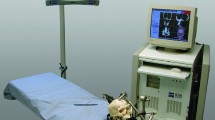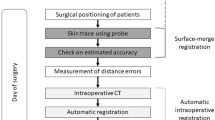Abstract
Objective
In many clinical applications of image-guided surgery, skin fiducial placement is poorly defined and occasionally poorly executed, leading to an increase in the target registration error (TRE). Fiducial placement analysis usually focuses on a single target, where surgical guidance requires accurate localization of a region or volume of tissue. To address these limitations, a method of fiducial positioning for minimizing the TRE in a target region was developed.
Method
This methodology uses patient specific anatomic data, the patient skin surface and accounts for areas which may be poor choices for fiducial placement due to likely fiducial motion. The effect of skin motion on the expected TRE of a target region was modeled and evaluated. Transorbital therapy delivery was selected as the application of interest, so facial morphology is of greatest importance. Our target region is the pyramidal space behind the globe of the eye. A laser range scan of the face of a skull phantom with taboo regions chosen semiautomatically was used as an input to the simulated annealing optimization algorithm.
Results
Optimizing the fiducial position reduced the expected TRE by 50% when compared to an unoptimized fiducial placement. In addition, the effect of fiducial motion or localizer fiducial localization error is also reduced in the optimized version.
Conclusion
Improved registration results for transorbital therapy delivery were achieved semiautomatically using optical facial surface scans for image-guided surgical localization. The target registration error minimization method was feasible for in vivo applications.
Similar content being viewed by others
References
West JB, Fitzpatrick JM, Toms SA, Maurer CRJ, Maciunas RJ (2001) Fiducial point placement and the accuracy of point-based, rigid body registration. Neurosurgery 48(4): 810–817
Labadie RF, Davis BM, Fitzpatrick MJ (2005) Image-guided surgery: what is the accuracy. Curr Opinion Otolaryngol Head Neck Surg 13: 27–31
Maurer CR Jr, Fitzpatrick JM, Wang MY, Galloway RL Jr, Maciunas RJ, Allen GS (1997) Registration of head volume images using implantable fiducial markers. IEEE Trans Med Imaging 16(4): 447–462
Barnett GH, Miller DW, Weisenberger J (1999) Frameless stereotaxy with scalp-applied fiducial markers for brain biopsy procedures: experience in 218 cases. J Neurosurg 91(4): 569–576
Atuegwu N, Mawn L, Galloway R Jr (2007) Transorbital Image Guidance. IEEE EMBS. Lyon France
Hummel J, Bax MR, Figl ML, Kang Y, Maurer C Jr, Birkfellner WW, Bergmann H, Shahidi R (2005) Design and application of an assessement protocol for electromagnetic traking systems. Med Phys 32(7): 2371–2379
Fitzpatrick JM, West JB, Maurer CR Jr (1998) Predicting error in rigid-body point-based registration. IEEE Trans Med Imaging 17(5): 694
Liu H, Yu Y, Schell MC, O’Dell W, Ruo R, Okunieff P (2002) Optimal marker placement in photogrammetry patient positioning system. Med Phys 30(2): 103–110
Bohachevsky IO, Johnson ME, Stein ML (1986) Generalized simulated annealing for function optimization. Technometrics 28(3): 209–217
Shechtman D, Shallo-Hoffmann J, Rumsey J, Riordan-Eva P, Hardigan P (2004) Maximum angle of ocular duction during visual fixation as a function of age. Strabismus 13(1): 21
Abramoff MD, Niessen WJ, Viergever MA (2000) Objective quantification of the motion of soft tissues in the orbit. IEEE Trans Med Imaging 19(10): 986
Dutton JJ (1994) Atlas of clinical and surgical orbital anatomy. W.B. Saunders, London
Jordan D, Anderson R (1996) Surgical anatomy of the ocular adnexa: a clinical approach
Labadie RF, Shah RJ, Harris SS, Cetinkaya E, Haynes DS, Fenlon MR, Juscyzk AS, Galloway RL, Fitzpatrick JM (2004) Submillimetric target-registration error using a novel, non-invasive fiducial system for image-guided otologic surgery. Comput Aided Surg 9(4): 145–153
Author information
Authors and Affiliations
Corresponding author
Rights and permissions
About this article
Cite this article
Atuegwu, N.C., Galloway, R.L. Sensitivity analysis of fiducial placement on transorbital target registration error. Int J CARS 2, 397–404 (2008). https://doi.org/10.1007/s11548-008-0150-8
Received:
Accepted:
Published:
Issue Date:
DOI: https://doi.org/10.1007/s11548-008-0150-8




